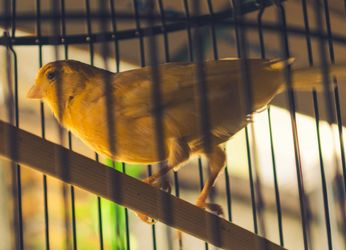
Feather cysts are often related to a damaged feather follicle, feather destructive behavior, hereditary conditions, or infectious causes. They are very common in canaries (Serinus canaria), especially in breeds with curled feathers. They occur when a feather begins to grow but is unable to penetrate the skin creating a cyst containing sebaceous secretions, feather shafts, keratin, and inflammatory cells. This is not a tumor but can still be very locally invasive into the surrounding tissues. Birds may have a history of damage to the feather follicle or feather destructive behavior. Due to this, it is not advised to routinely pluck bleeding blood feathers anymore unless absolutely necessary.
Symptoms include focal swelling of the skin, abnormally growing feathers, and feather loss around the affected area. Discoloration or necrosis of the overlying skin may occur with very large cysts. Cysts are often firm on palpation and contain thick, cheesy discharge. Birds often have multiple lesions with a similar appearance.
Conditions that may appear similar include Xanthomas or other tumors, soft tissue injuries, underlying musculoskeletal abnormalities, Psittacine Beak and Feather Disease (PBFD), hematomas, abscesses, bacterial or fungal infections, malnutrition, or ectoparasites.
Your vet may recommend a fine needle aspirate or an impression smear of contents of the cyst.
Radiographs may be recommended if there is concern about bone involvement. Blood testing may be also recommended to evaluate the patient’s overall health. If a contagious disease is suspected, specific infectious disease testing (PBFD, etc) is indicated.
Under sedation or general anesthesia, your veterinarian will lance and remove cystic material. Cauterization may be necessary for chronic cysts that may bleed excessively. Surgical removal of the follicle may be necessary. Following the procedure your bird will be prescribed pain medications and antibiotics along with any additional supportive care the bird may need
The prognosis for this condition is fair, but it should be noted that they often recur. If the cyst involves a significant amount of soft tissue and the patient is systemically ill, the prognosis is guarded.
After the initial visit, follow up in 5-7 days to monitor wound healing. Additional debridement may be necessary. Recheck again at the end of antibiotic treatment.
Copyright © All Rights Reserved
